Atlanta City Hall
Introduction
Text-to-speech Audio
Atlanta's current City Hall is the forth since the founding of the city, and was completed in early 1930 and was designed by G. Lloyd Preacher. The Gothic Revival style towering building with Art Deco details was added to the National Register of Historic Places in 1983. The interior and exterior feature Georgia-made marble, granite, terra cotta, and brick. Heavy bronze doors lead to an ornate lobby with double marble staircases. The building was renovated in 1986 and the exterior was designated a City of Atlanta Landmark Building in 1989. An annex behind the building on Trinity Ave. SW was built to house more of the city's offices in the late 1980s.
Images
Front of Atlanta City Hall number 4 photographed in 1982, looking west (James R. Lockhart for NRHP)
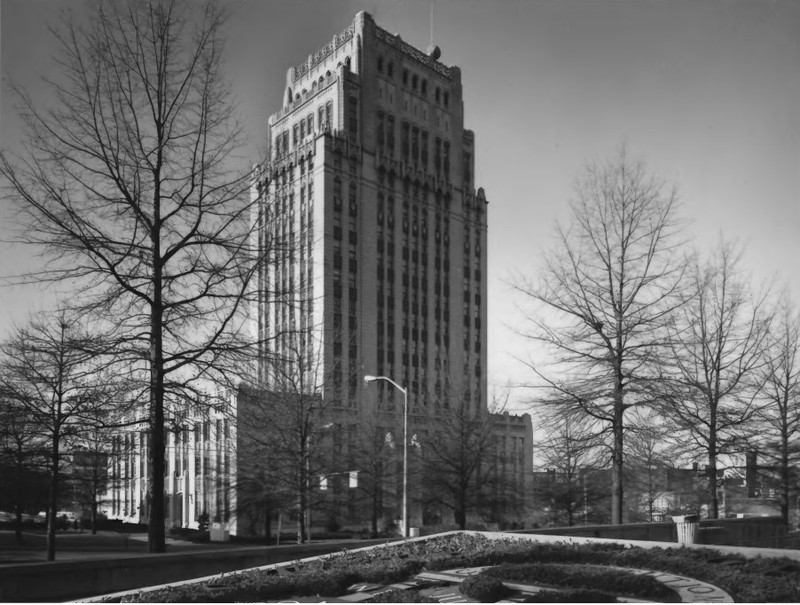
Rear view of Atlanta City Hall, looking north in 1982 (Lockhart)
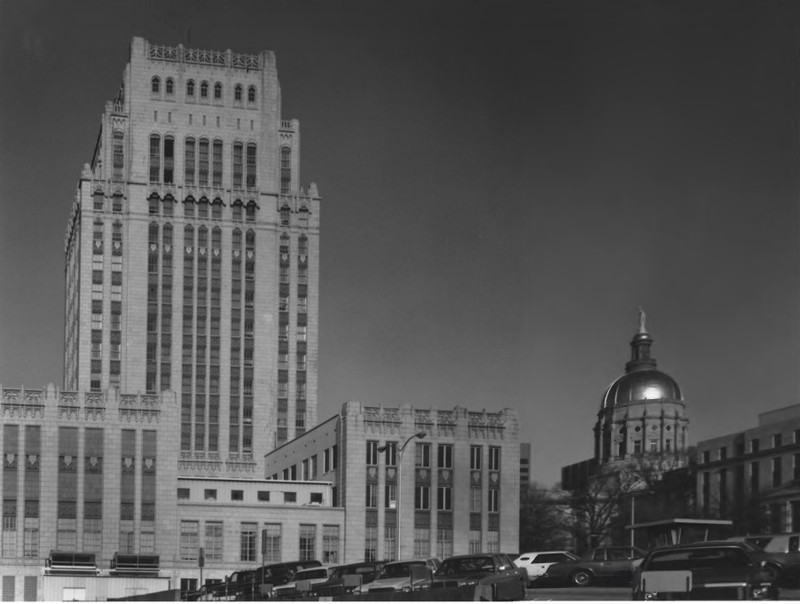
Detail of main entrance to Atlanta City Hall, looking southwest in 1982 (Lockhart)
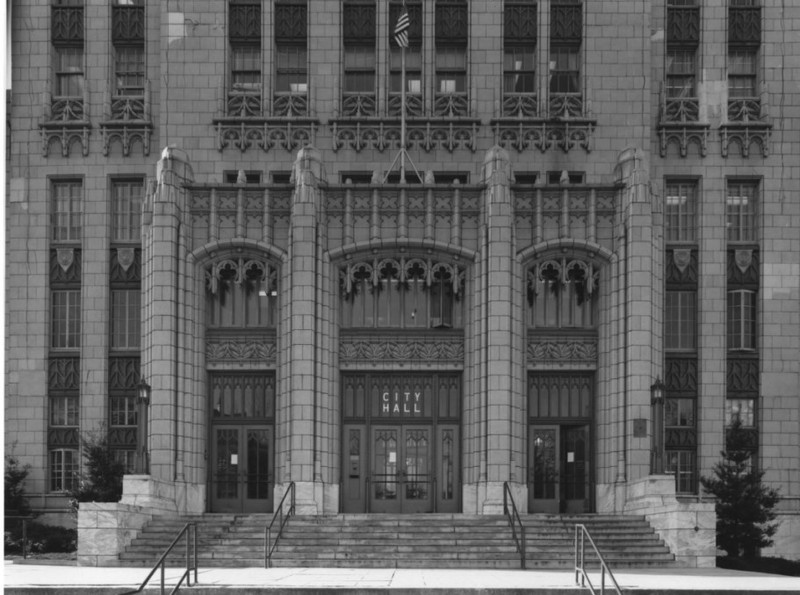
Atlanta City Hall lobby viewed from stair landing in 1981 (Gabriel Benzur for HABS)
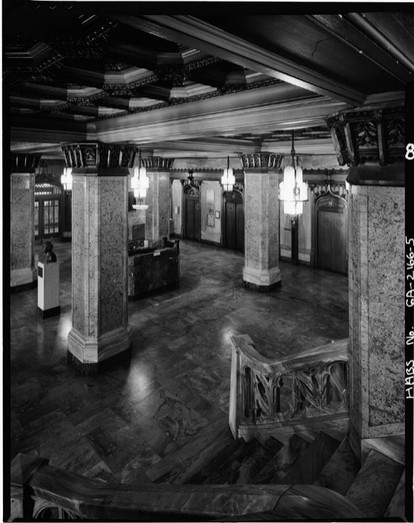
Original City Hall in 1864 photograph with Union encampment (George N. Barnard for U.S. Army Chief Engineer's Office)
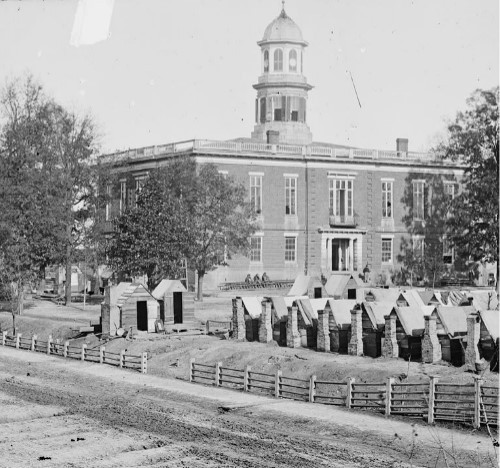
City Hall number three in 1910s-1920s colorized postcard image, old Post Office and Customs House
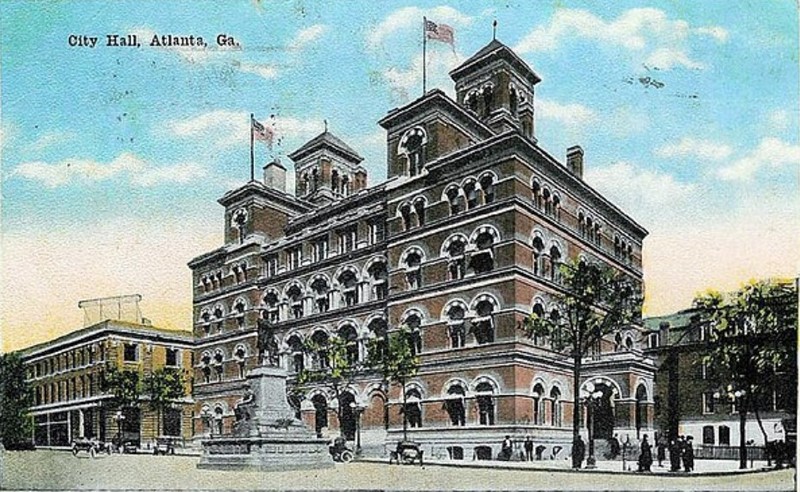
Backstory and Context
Text-to-speech Audio
Atlanta's first city hall was located across the street from the 1930 city hall, where the Georgia State Capitol building now stands. The first city hall, a two-story, wood frame building topped by a cupola, served from 1855 to 1882 and doubled as the Fulton County Courthouse. The second city hall was within a building owned by the Atlanta Chamber of Commerce at Prior St. and MLK Jr. Drive. The second city hall also was used as a Masonic Lodge and served the city from 1882 to 1911. Atlanta's third city hall, from 1911 to 1930, was at Marietta and Forsyth Streets, in the old Post Office and Customs House.
Construction began on the foundation of a new building to house Atlanta's fourth City Hall in July 1928. The project was financed by a $1 million bond approved by local voters in 1926. the cost ended up being $1.25 million. Local architect Geoffrey Lloyd Preacher (1882-1972) designed the structure in a blend of Art Deco and Gothic Revival architectural styles. Preacher was born in South Carolina in 1882 and began his practice in Augusta in 1909. He and his family moved from Augusta to Atlanta in 1922. He designed a number of other buildings in Atlanta, including the Briarcliff Hotel, the Medical Arts Building, and the former Henry Grady Hotel. Preacher went on to design over 400 structures in seven states from offices in Atlanta and Florida.
National Construction Company finished the new Atlanta City Hall building in February 1930; all city records were moved here on February 22nd. The massive structure of 160 by 116 feet faces Mitchell Street and is set back 80 feet. A three-story base is topped by an eleven-story office tower of 82 by 54 feet. Brick piers with inset terra cotta spandrels give the design a strong verticality. The marble, granite, brick, and terra cotta used on the exterior and parts of the interior were products of Georgia. Cream-colored terra cotta tiles cover the exterior except for the vertical piers above windows where green terra cotta designs are found. White Georgia marble is seen on the entrance and balustrade facing Mitchell. The ground floor was designed for office space. records storage, and a sandwich shop. The main or first floor resembles a grand banking hall with elaborate bronze fixtures; heavy bronze doors mark the building's entrance and its four elevators. The lobby features marble flooring and wainscoting and a gilded ceiling. The Mayor's Suite and Council Chambers were on the second floor. The fifteenth floor was intended to be a bell tower but has instead been used as an observation spot.
An annex on Trinity Ave. SW behind the 1930 City Hall was built to house more of the city's offices in the late 1980s; the annex is connected to the 1930 building on the first and second floors. Additional space for city offices was located in "City Hall East" on Ponce de Leon Ave. from 1990 to 2010. That building has been sold and was transformed into "Ponce City Market."
Sources
City of Atlanta Department of City Planning. Atlanta City Hall, Historic Preservation: Property & District Information. October 23rd, 1989. Accessed March 2nd, 2023. https://www.atlantaga.gov/government/departments/city-planning/office-of-design/urban-design-commission/atlanta-city-hall.
Craig, Robert M. Atlanta City Hall, Society of Architectural Historians, SAH Archipedia. January 1st, 2023. Accessed March 3rd, 2023. https://sah-archipedia.org/buildings/GA-01-121-0061.
Gwinner, Susan E. Survey of Atlanta City Hall, 68 Mitchell St. S.W., Atlanta, Georgia, HABS No. GA-2166. Historic American Buildings Survey. Washington, DC. U.S. Department of the Interior, 1981.
Homas, Kenneth H. Jr. NRHP nomination of Atlanta City Hall, 68 Mitchell St., S.W., Atlanta, Georgia. National Register. Washington, DC`. National Park Service, 1983.
Mullins, Robert A. Augusta History Reader. online. Xlibris.com, 2021.
National Park Service (NPS): https://npgallery.nps.gov/AssetDetail/NRIS/83000227
NPS: https://npgallery.nps.gov/AssetDetail/NRIS/83000227
NPS: https://npgallery.nps.gov/AssetDetail/NRIS/83000227
U.S. Department of the Interior: https://www.loc.gov/item/ga0460/
LOC, Prints and Photographs Division: https://www.loc.gov/item/2018666990/
https://en.wikipedia.org/wiki/Atlanta_City_Hall#/media/File:U.S._Post_Office_and_Customs_House_(Atlanta)_when_used_as_City_Hall_1910s-1920s.jpg
